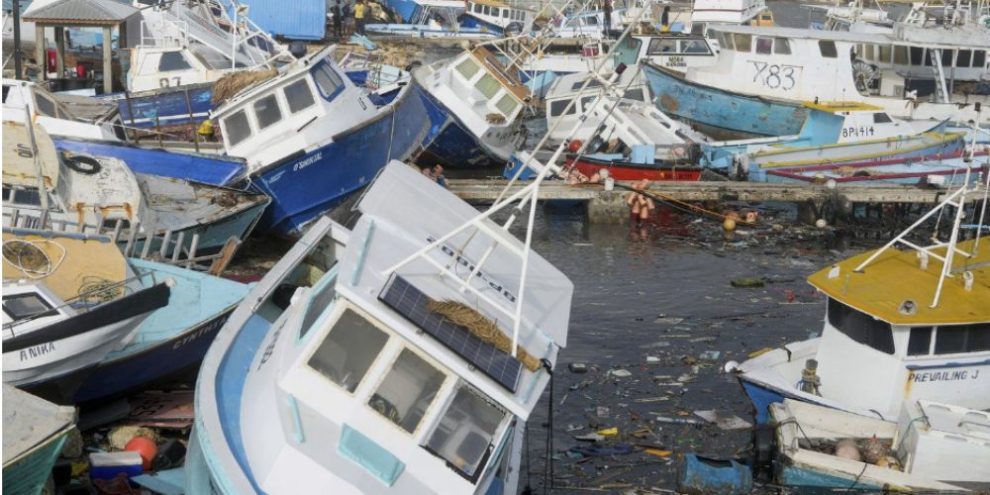
ST. GEORGE'S, Grenada (AP) — Hurricane Beryl roared through open waters on Tuesday as a monstrous Category 5 storm heading toward Jamaica after earlier making landfall in the southeast Caribbean, killing at least four people.
A hurricane warning was in effect for Jamaica and a hurricane watch for Grand Cayman, Little Cayman, Cayman Brac and for Haiti's entire southern coast. Beryl was forecast to start losing intensity on Tuesday but still be near major hurricane strength when it passes near or over Jamaica early Wednesday, near the Cayman Islands on Thursday and into Mexico's Yucatan Peninsula on Friday, according to the National Hurricane Center.
The center said Beryl was expected to bring life-threatening winds and storm surge to Jamaica, where officials warned residents in flood-prone areas to prepare for evacuation.
“I am encouraging all Jamaicans to take the hurricane as a serious threat,” Prime Minister Andrew Holness said in a public address late Monday. “It is, however, not a time to panic.”
Beryl is the earliest Category 5 storm ever to form in the Atlantic, fueled by record warm waters.
Late Tuesday morning, the storm was located about 235 miles (375 kilometers) southeast of Isla Beata in the Dominican Republic. It had top winds of 160 mph (260 kph) and was moving west-northwest at 22 mph (35 kph).
In Miami, National Hurricane Center Director Michael Brennan said Jamaica appears to be in the direct path of Beryl.
“We are most concerned about Jamaica, where we are expecting the core of a major hurricane to pass near or over the island,” he said in an online briefing. “You want to be in a safe place where you can ride out the storm by nightfall (Tuesday). Be prepared to stay in that location through Wednesday.”
Storm surge of 5-8 feet above typical tide levels are likely in Jamaica, as well as heavy rainfall.
“This is a big hazard in the Caribbean, especially with the mountainous islands,” Brennan said. “This could cause life threatening flash floods and mudslides in some of these areas.”
A tropical storm warning was in place for the entire southern coast of Hispaniola, an island shared by Haiti and the Dominican Republic.
Trail of devastation
As the storm barreled through the Caribbean Sea, rescue crews in the southeast Caribbean fanned out across the region to determine the extent of the damage that Hurricane Beryl inflicted after landing on Carriacou, an island in Grenada, as a Category 4 storm.
Three people were reported killed in Grenada and Carriacou and another in St. Vincent and the Grenadines, officials said.
One fatality in Grenada occurred after a tree fell on a house, Kerryne James, minister of climate resilience, environment and renewable energy, told The Associated Press.
She said the nearby islands of Carriacou and Petit Martinique sustained the greatest damage, with water, food and baby formula a priority.
An emergency team was expected to travel Tuesday morning to Carriacou, where Beryl flattened scores of homes and businesses.
"The situation is grim," Grenadian Prime Minister Dickon Mitchell told a news conference Tuesday. “There is no power, and there is almost complete destruction of homes and buildings on the island. The roads are not passable, and in many instances they are cut off because of the large quantity of debris strewn all over the streets.”
Mitchell added: "The possibility that there may be more fatalities remains a grim reality as movement is still highly restricted.”
Meanwhile, Ralph Gonsalves, prime minister of St. Vincent and the Grenadines, promised to rebuild the archipelago in a statement early Tuesday. He noted that 90% of homes on Union Island were destroyed, and that “similar levels of devastation” were expected on the islands of Myreau and Canouan.
The last strong hurricane to hit the southeast Caribbean was Hurricane Ivan 20 years ago, which killed dozens of people in Grenada.
Grenadian resident Roy O'Neale, 77, recalled how he lost his home to Ivan and built back stronger, with his current home sustaining minimal damage from Hurricane Beryl.
“I felt the wind whistling, and then for about two hours straight, it was really, really terrifying at times,” he said by phone. “Branches of trees were flying all over the place.”
Hundreds of people hunkered in shelters across the southeast Caribbean, including 50 adults and 20 children who huddled inside a school in Grenada.
“Maybe some of them thought they could have survived in their homes, but when they realized the severity of it … they came for cover,” said Urban Mason, a retired teacher who served as the shelter's manager. “People tend to be complacent.”
One of the homes that Beryl damaged belongs to the parents of U.N. Climate Change Executive Secretary Simon Stiell, who is from Carriacou. The storm also destroyed the home of his late grandmother.
In a statement, Stiell said that the climate crisis is going from bad to worse, and faster than expected.
“Whether in my homeland of Carriacou … hammered by Hurricane Beryl, or in the heatwaves and floods crippling communities in some of the world’s largest economies, it’s clear that the climate crisis is pushing disasters to record-breaking new levels of destruction,” he said.
Grenada, known as the “spice isle,” is one of the world's top exporters of nutmeg. Mitchell noted that the bulk of spices are grown in the northern part of the island, which was hit hardest by Beryl.
Historic hurricane
Beryl has broken several records, including marking the farthest east that a hurricane has formed in the tropical Atlantic in June, according to Philip Klotzbach, Colorado State University hurricane researcher.
The storm strengthened from a tropical depression to a major hurricane in just 42 hours, which only six other Atlantic hurricanes have done, and never before September, according to hurricane expert Sam Lillo.
Beryl is the second named storm in the Atlantic hurricane season, which runs from June 1 to Nov. 30. Earlier this month, Tropical Storm Alberto made landfall in northeast Mexico and killed four people.
The National Oceanic and Atmospheric Administration predicted the 2024 hurricane season would be well above average, with between 17 and 25 named storms. The forecast called for as many as 13 hurricanes and four major hurricanes.
An average Atlantic hurricane season produces 14 named storms, seven of them hurricanes, and three major hurricanes.
___
Coto reported from San Juan, Puerto Rico. Associated Press writers Anika Kentish in St. John, Antigua and Curt Anderson in St. Petersburg, Florida, and Associated Press videographer Lucanus Ollivierre in Kingstown, St. Vincent, contributed to this report.





